| Observation data Epoch J2000.0 Equinox J2000.0 (ICRS) | |
|---|---|
| Constellation | Andromeda [1] |
| Right ascension | 00h 21m 17.5s [2] |
| Declination | +22° 27′ 37″ [2] |

NGC 82 is a magnitude 14.8 star located in the Andromeda constellation. It was first recorded by French astronomer Guillaume Bigourdan on October 23, 1884. [3]